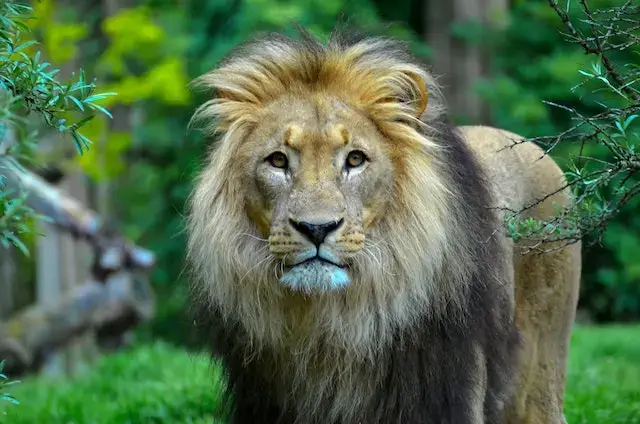Tibetan Mastiff vs Lion: Who Would Win?

You probably have a Tibetan Mastiff as a pet if you read this article. He is solid, muscular, and powerful and never fails to make you proud.
This has reached a point where you feel he is the most powerful animal on Earth until you remember the Lion.
And now you sit there wondering who would win if your pet can fight the Lion—Tibetan Mastiff vs Lion?
Well, that is what we are here to see, so read for all the answers you will get in this little article.
Tibetan Mastiff vs Lion: Quick Comparison
| Tibetan Mastiff | Lion | |
|---|---|---|
| Classification | Mammal – Canine family (Dog) | Mammal – Feline family (Big Cat) |
| Height | 24-26 inches (60-70 cm) | 47-49 inches (120-125 cm) |
| Length | 36-45 inches (91-114 cm) | 67-98 inches (170-250 cm) |
| Weight | 88-170 lbs (40-77 kg) | 240-550 lbs (110-250 kg) |
| Lifespan | 12-15 years | 10-14 years (in the wild) |
| Habitat | Domesticated (originally mountains) | Savannas, grasslands, and woodlands |
| Distribution | Native to Tibet | Africa and a small population in India |
| Diet | Omnivore (primarily carnivorous) | Carnivore |
| Social Group | Family packs | Prides |
| Role | Livestock guardian, companion | Apex predator, herd control |
| Color | Black, brown, red, gold, gray | Tawny yellow, white (rare) |
So, there you go. To begin with, these are two animals emerging from entirely different families and originating from other continents. And then, while the
Mastiff is enormous for a dog, and he is not as massive or heavy as the Lion.
Coming from the mountains, he is more comfortable in your home than in the jungle, like the mighty Lion. While one is an omnivore, the other one’s diet is meat and only meat.
Now that you have seen the differences between the two, read on to see if the Lion can lose a fight against the mighty Mastiff.
Must Read: Dudley Lab vs Yellow Lab
Tibetan Mastiff vs Lion: Similarities & Differences

While some would agree that a Tibetan mastiff is no match to the mighty Lion, others think its size and strength make it equal to the Lion. So, here are the similarities and differences.
Similarities
Often one would look at the two animals thinking they have a lot in common, so if you are one of them, read on to correct this misconception.
- Size: If you were to see the picture of the Mastiff, one of the first similarities you would notice is that both animals are enormous, though the Lion is more extensive and heavier.
- Coat color variations: Both species exhibit a range of colors in their fur, with most individuals having a tawny or reddish-brown coat.
- Courage: Like the Lion, the Tibetan Mastiff is one courageous dog, so much so that he will challenge the Lion, though he may not come out victorious.
- Protectiveness: Tibetan Mastiffs and Lions are protective of their family or pride. They will fiercely defend their loved ones against any perceived threat.
Differences
Now, for the differences, here are some of them you would have already seen and others you will now see.
- Fur: As you would already know, lions have a mane. On the other hand, the Mastiff has a long double coat that comes in various colors, from black to tan to shades of red. Yellow is all you find when it comes to lions.
- Instincts: A lion comes with natural hunting and survival instincts, so it shows its aggression. On the other hand, mastiff fights to protect whenever he sees a threat.
- Life Span: Lions live longer than the Tibetan Mastiff, enjoying two to three extra years, and this is more so when in captivity, where they are now provided with all their needs.
- Diet: Tibetan Mastiffs are omnivores, meaning they eat both meat and plant-based foods. Lions, on the other hand, are carnivores and primarily eat meat.
And these are a few significant factors that make the Lion so much more different from the Tibetan Mastiff.
Tibetan Mastiff vs Lion: Origin & History

As the name suggests, these dogs originate from Tibet, where their power and strength made them good candidates to protect their Buddhist masters from various threats.
Tibetan Mastiff is also considered one of the world’s oldest precious breeds and is believed by some researchers to be the ancestor of many large mastiff breeds on the European continent. And their existence is since 1100 BC, meaning they have been living for centuries.
That said, let’s come to the king of the jungle and look at his origin. Now this one mainly evolved in Africa before diversifying into different species, migrating and conquering the other jungles of the world.
Lions have been known since the earliest times and have been depicted in sculptures, paintings, and literature throughout history. They are most active at night and live in a variety of habitats, including grasslands, savannas, and shrublands.
Tibetan Mastiff vs Lion: Behaviour and Temperament
While the former is more of a house guard, loving and protective, the latter is more of a predator with enough experience and power.
True, lions are generous, and they are friendly and good communicators and all those things that you see on Instagram and Facebook, but that is (like in the case of the mastiff) when they are trained.
What is more glaring in a lion is its dangerous side which is much more dangerous than the dog that is the mastiff.
The lion is an animal built for killing almost any living creature it sees (leaving aside the members of his clan).
On the other hand, the Mastiff is strong-willed, intelligent, and a potential threat to intruders at home; he is a sweet and loyal pet that cares deeply for his owner and fights only when he has to protect him.
Tibetan Mastiff vs Lion: Strength & Agility

Yes, the Tibetan Mastiff is one of the largest and strongest breeds of dogs that you can find, but not the largest and most robust among all animals. They are also capable of pulling large weights, with some reports stating that they can pull an average of 390 pounds, with bigger and stronger Tibetan Mastiffs being able to pull over 7000 pounds.
The Lion will any day come out more assertive with his heavier build, more powerful jaws, and survival instincts that come from years of fighting in the jungle to kill.
In terms of agility, Tibetan Mastiffs are not usually known for their agility and do not typically do well in obedience or agility competitions. On short distances, they can reach speeds of 20 mph (32 km/h). Lions, while not as agile as some other big cats, such as tigers, are still powerful and athletic animals. They can run up to 80 km/h for short bursts and jump more than 10 feet vertically.
In short, the strength and agility of the Mastiff can scare a human being, but not a lion.
Tibetan Mastiff vs Lion: Bite Force & Fighting Abilities
The Tibetan Mastiff has a powerful bite force of about 600 psi. And from this, we can safely conclude that it shares one of the strongest bite powers of all dog breeds.
But honestly, this is nothing compared to the bite force of a lion that stands at 1000 psi.
True, some lions come with a slightly lower bite power, but this still does not give a chance to the Mastiff because the Lion has more muscular paws and agile movements than a lion.
Lions are also approximately four times stronger than humans.
Tibetan Mastiff vs Lion: Who Would Win in a Fight?
There is no doubt that the Tibetan Mastiff is a large and robust dog, but here is what will happen when it confronts a lion.
For one, he is going to come under the razor-sharp claws of the Lion (and double the bite force as we saw above)
So, no matter how much you like the Mastiff, if the two were to fight, there are all chances that the Lion will win.
If it makes you feel any better, the Mastiff could win in a group with other mastiffs against a lone lion, but not if he is alone with only the Lion for company.
What Dog Can Challenge a Lion?

The truth is that no breed of dog can fight a lion to the finish, no matter how strong it is and how powerful a bite force it has. The Lion will emerge more robust with its size and other advantages, like its speed and agility.
However, if you still want some names, here are some dogs that could fight a lion and win if they are lucky and it is their day.
To begin with, there is the rottweiler with a height of 27 inches and excellent hunting skills. Then some bloodhounds can fight without fear. Some other names that you have are the boerboel, cane corso, wolfdog, kangal, Irish wolfhound and bandog.
Again, we say that they can challenge the Lion, but we give you no guarantee that they will win.
Frequently Asked Question: Tibetan Mastiff vs Lion
There you are, obviously not satisfied now that you know the Lion can beat your Mastiff, and so, here are a few more answers to leave you convinced.
Q1. Is a Tibetan Mastiff stronger than a lion?
Ans: No, the Lion is any day stronger and a more experienced fighter. Added to that are his build, sharp claws, and greater bite force, all of which make the Lion emerge stronger.
Q2. Which dog is stronger than the Tibetan Mastiff?
Ans: The rottweiler, for one. Then, you have the Caucasian shepherd, kangal, and bandog, all of which though not more robust than the Lion, are still found to be powerful dogs, more robust than a Tibetan mastiff that gets a slightly lower place on this list.
Q3. Is a Tibetan Mastiff stronger than a wolf?
Ans: No, it is not stronger than the wolf either, so if the two were to fight here again, the wolf would emerge as the winner; so if you ever see a wolf, make sure that you keep it away from your Mastiff.
Final Thoughts
Tibetan Mastiff vs. Lion: who will win? No, the Mastiff will not win, but that gives you no reason to stop being proud of him.
After all, this guy is any day a better pet; he will guard your house and won’t make you scared of him (things you can’t imagine when it comes to the Lion, can you?)
Okay, now enough about the Lion. Let him continue to be the jungle king while the Mastiff remains the adorable pet to your family and all around you.






